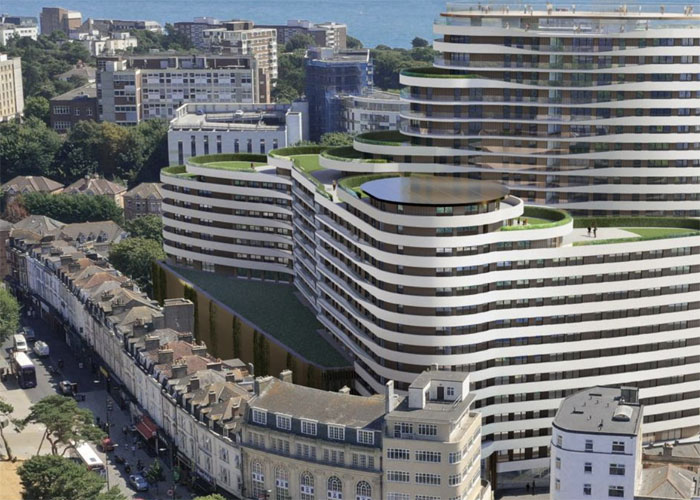Dorset-based ARC Architecture has won approval for a 24-storey housing, hotel and nightclub scheme close to Bournemouth seafront, despite concerns about a lack of affordable housing and its visual impact on the surrounding area.
Developer Fortitudo will knock down the existing buildings on Glen Fern Road, which include a seven-storey car park, a café and a car wash, replacing them with a 14-storey and 24-storey tower. The architect described the 14-storey section as the development's ‘mainstay building’, with a 24-storey tower in the middle.
The scheme includes 494 flats, a 104-room hotel, a multistorey car park and a nightclub and bar. The building will largely be faced with Portland stone. Fortitudo described the turret roofs and dormer windows at the top of the scheme as reminiscent of the area’s Edwardian past.
The developer added that recessed balconies with arched top windows in the top storeys were another nod to traditional architecture in the area.
They also defended the demolition on the grounds that one of the affected buildings had been part-owned by disgraced DJ Jimmy Savile.
Planning officers for Bournemouth, Christchurch and Poole Council recommended refusal of the new building because of its height, and the effect it would have on other buildings nearby, including a loss of sunlight.
The local authority's planners also said the size of the flats – all one or two bedrooms – went against the local development plan.
But councillors nevertheless approved the plans by eight votes to five.
A spokesperson for Historic England said that the organisation was 'disappointed' with the approval, saying: ‘This is a massive building which will dominate and define Bournemouth’s townscape, including key views of the Grade I listed St Peter’s Church from the town’s famous pleasure gardens.
‘We advocate a plan-led approach to tall buildings, and there are a number of areas identified by the council’s local plan where tall buildings could be constructed without compromise to the town’s distinctive character. Glen Fern Road is not amongst them.’
Labour councillor George Farquhar, who voted against the proposals, told the AJ afterwards that the plans were ‘way out of step with the local housing needs’.
He added that affordable properties were ‘sadly severely lacking with so many development proposals and the conurbation has a huge shortfall on affordable housing and social rent.’
ARC director Bradley Cheer said: ‘We worked closely with Fortitudo Property to deliver this regeneration project in the centre of Bournemouth. The key desire was to achieve a landmark building with a sculptural form providing a stark contrast with the sharp edges of the existing building and surrounding vernacular.
‘The perimeter balconies achieve the curvaceous form in a simplistic manner while offering substantial outside space to all apartments.’
Fortitudo boss Richard Carr pushed back against the objections and said he was ‘completely confused’ by the planners’ criticism of the scheme’s effect on nearby buildings.
‘The current urban context is appalling and in a state of dilapidation,’ he said during the meeting. ‘You'd be forgiven for wondering what context are we trying to integrate with or be sympathetic to. We are simply trying to regenerate this area.’
Carr added that the existing building was ‘once voted one of the ugliest buildings in the United Kingdom’.
Addressing the lack of affordable housing, Carr said that including affordable homes would make the scheme financially unviable. He pointed out that there are thousands of households currently in temporary accommodation in Bournemouth, Christchurch and Poole, which he called ‘unsustainable’. He suggested that building this scheme could free up cheaper homes for people in temporary housing to move into.
Commenting on the lack of family-sized homes in the scheme, Carr insisted that ‘the demand in the town centre is for one and tw0-bedroom apartments’. He also pointed to an ‘unfortunate increase in divorce’ over recent decades as a driver for the growing number of people choosing to live alone, for whom smaller flats would be suitable.
In an unusual tack, he also said his scheme should be approved because one of the existing buildings on the site had been part-owned by the late DJ and serial sex offender Jimmy Savile.
‘We all have opinions about whether statues of historical figures should be pulled down in city centres,’ he said. ‘But I think we can all agree that the legacy of that man, no matter in what form, should be erased completely from the history books.’
As for the lighting impact, Carr told the planning committee: ‘Clearly, any town in the UK that is going through a regeneration phase is going to injure certain lighting levels of certain neighbouring properties.’
He also said that the blocks of flats in Bath Hill Court, approved in the 1930s, were controversial at the time because of their size compared to neighbouring buildings, and yet ‘91 years later the architecture is praised’.
Also speaking at the planning meeting, Paul Kinvig, the head of the Bournemouth business improvement district, said the development would help make Bournemouth an attractive place for people to come to all year round.
He added: ‘Our towns and cities are almost going back to where they were in the Middle Ages, which is where people gathered and people lived.’
Urging the committee to approve the scheme, Kinvig said: ‘We need to be brave. Pandemics, cost of living crises, climate crises are no respecters of policy. I wouldn't suggest anything other than be brave.’



